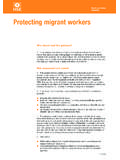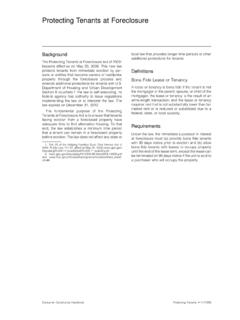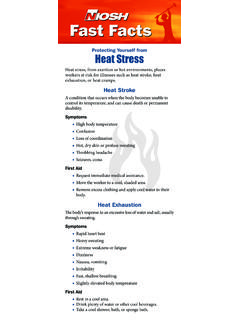Transcription of Fast Facts - Centers for Disease Control and Prevention
1 Anyone working outdoors is exposed to the sun s ultraviolet (UV) rays, even on cloudy days. UV rays are a part of sunlight that is an invisible form of radiation. There are three types of UV rays. UVA is believed to damage connective tissue and increase the risk for developing skin cancer. UVB penetrates less deeply into the skin, but can still cause some types of skin cancer. Natural UVC is absorbed by the atmosphere and does not pose a risk. SunburnSunburn is not immediately apparent. Symptoms usually start about 4 hours after sun exposure, worsen in 24 36 hours, and resolve in 3 5 days. They include red, tender and swollen skin, blistering, headache, fever, nausea, and fatigue.
2 In addition to the skin, eyes can become sunburned. Sunburned eyes become red, dry, painful, and feel gritty. Chronic eye exposure can cause permanent damage, including Aid Take aspirin, acetaminophen, or ibuprofen to relieve pain, headache, and fever. Drink plenty of water to help replace fluid losses. Comfort burns with cool baths or the gentle application of cool wet cloths. Avoid further exposure until the burn has resolved. Use of a topical moisturizing cream, aloe, or 1% hydrocortisone cream may provide additional blistering occurs: Lightly bandage or cover the area with gauze to prevent infection.
3 Do not break blisters. (This slows healing and increases risk of infection.) When the blisters break and the skin peels, dried skin fragments may be removed and an antiseptic ointment or hydrocortisone cream may be applied. Seek medical attention if any of the following occur: Severe sunburns covering more than 15% of the body Dehydration High fever (>101 F) Extreme pain that persists for longer than 48 hours Fast FactsSun ExposureProtecting Yourself fromSkin CancerSkin cancer is the most common form of cancer in the United States. The most common types of skin cancer include basal cell carcinoma, squamous cell carcinoma, and of skin cancer may include: Irregular borders on moles (ragged, notched, or blurred edges) Moles that are not symmetrical (one half doesn t match the other) Colors that are not uniform throughout Moles that are bigger than a pencil eraser Itchy or painful moles New moles Sores that bleed and do not heal Red patches or lumpsProtect Yourself Avoid prolonged exposure to the sun when possible.
4 Wear sunscreen with a minimum of SPF 15. SPF refers to how long a person will be protected from a burn. (SPF 15 means a person can stay in the sun 15-times longer before burning.) SPF only refers to UVB protection. To protect against UVA, look for products containing: Mexoryl, Parsol 1789, titanium dioxide, zinc oxide, or avobenzone. Sunscreen performance is affected by wind, humidity, perspiration, and proper application. Throw away sunscreens after 1 2 years (they lose potency). Apply liberally (minimum of 1 oz) at least 20 minutes before sun exposure. Apply to ears, scalp, lips, neck, tops of feet, and backs of hands.
5 Reapply at least every 2 hours and each time a person gets out of the water or perspires heavily. Some sunscreens may lose their effectiveness when applied with insect repellents. You may need to reapply more often. Wear clothing with a tight weave or high-SPF clothing. Wear wide-brimmed hats and sunglasses with UV protection and side panels. Take breaks in shaded OF HEALTH AND HUMAN SERVICESC enters for Disease Control and PreventionNational Institute for Occupational Safety and (NIOSH) Publication No. 2010 116 Telephone: 1 800 CDC INFOTTY: 1 888 232 6348E-mail: healthier people















